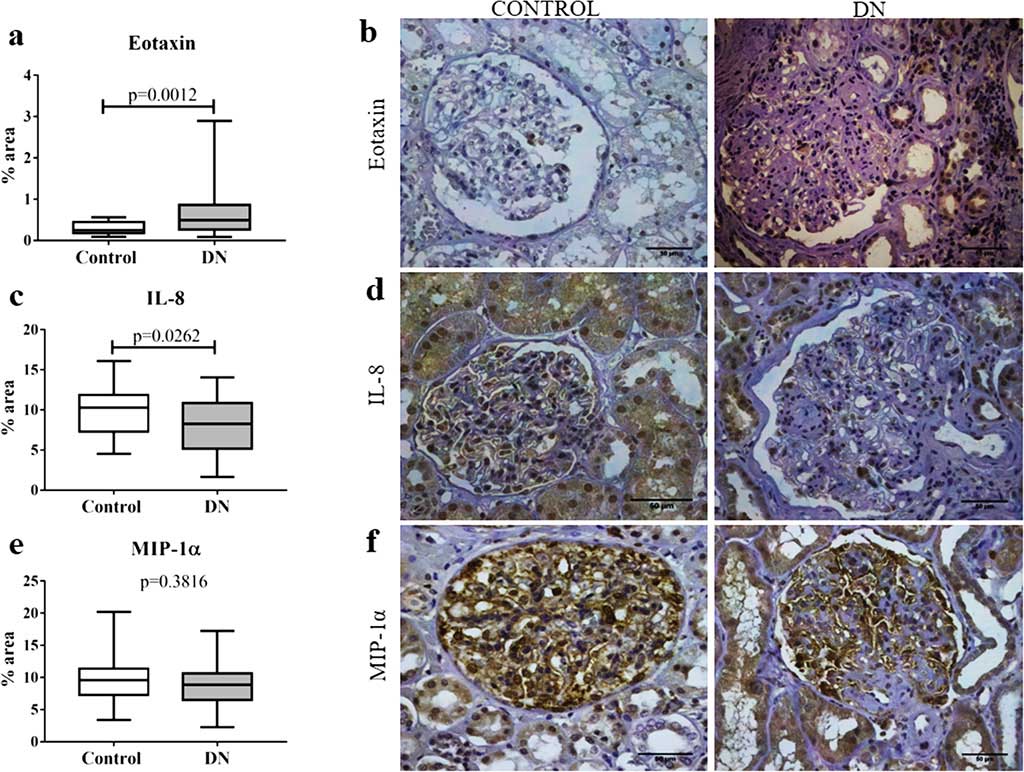Renal Expression of Immunomodulators in Diabetic Nephropathy
By LabMedica International staff writers
Posted on 12 Aug 2020
Diabetic nephropathy (DN) is a chronic microvascular complication that affects about 20% to 30% of patients with type 2 diabetes mellitus (T2DM). It is considered the leading cause of end-stage renal failure requiring renal replacement therapy.Posted on 12 Aug 2020
Immune and inflammatory mechanisms play important role in the development and progression of DN, which is considered a chronic inflammatory disease. Several cells, such as monocytes, macrophages, and lymphocytes, as well as the immunomodulators chemokines and cytokines, have been implicated in this process.

In situ expression of chemokines eotaxin, IL-8, and MIP-1α in glomerular and tubulointerstitial compartments in patients with diabetic nephropathy (DN) and control group (Photo courtesy of Federal University of Triângulo Mineiro).
Medical scientists at the Federal University of Triângulo Mineiro (Uberaba, Brazil) selected 44 native renal biopsies from patients with DN and 23 control cases. The diagnosis of DN was performed with three samples used for light microscopy (LM), direct immunofluorescence (IF) and transmission electron microscopy (TEM). For LM, 2-μm paraffin sections were stained with hematoxylin and eosin (H&E), Sirius red, methenamine silver, and Masson’s trichrome. LM was used to analyze morphological changes and interstitial inflammation.
Immunohistochemistry was performed manually on slides containing paraffin-embedded tissue sections using the Novolink Polymer Detection System Kit, a non-biotin polymer system (Leica Biosystems, Nussloch, Germany; www.leicabiosystems.com). In situ expression of eotaxin, macrophage inflammatory protein-1α (MIP-1α), interleukin-8 (IL-8), IL-4, IL-10, tumor necrosis factor-α (TNF-α ), tumor necrosis factor receptor-1 (TNFR1), IL-1β, and IL-6 were evaluated by immunohistochemistry. Immunostained cells showing an intense brownish staining were marked by the observer using the interactive AxionCam ICc 5 image analysis system (Carl Zeiss Microscopy GmbH, Jena, Germany; www.zeiss.de).
The team reported that the DN group showed a significant increase in IL-6, IL-1β, IL-4 and eotaxin expression, and a decrease in TNFR1 and IL-8 expression compared to the control group. However, there were no significant differences in IL-10, TNF-α, and MIP-1α expression among groups. With interstitial inflammation, there was a significant increase in IL-6 in scores 0 and 1 compared to score 2 , in IL-10 in score 2 compared to score 0, and in eotaxin in score 2 compared to scores 0 and 1, whereas IL-8 and MIP-1α showed no significant differences. There was a tendency for negative correlation between eotaxin and estimated glomerular filtration rate (eGFR).
The authors concluded that that in situ expression of cytokines and chemokines, including IL-6, IL-1β, IL-4 and eotaxin, is increased in patients with DN. It was observed that, possibly, eotaxin may have an important role in progression of interstitial inflammation in DN and in the decrease of eGFR of these patients. The study was published on July 28, 2020 in the journal BMC Nephrology.
Related Links:
Federal University of Triângulo Mineiro
Leica Biosystems
Carl Zeiss Microscopy




 assay.jpg)







